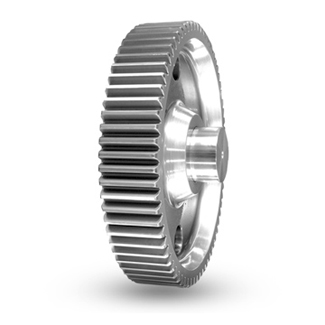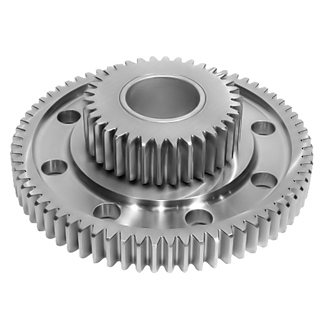In modern industrial systems, helical gears serve as core components for power transmission and speed conversion, and their performance directly determines the operating efficiency and stability of mechanical equipment. Especially in high-precision applications such as robotic joints and new energy vehicles, high-quality, customized helical gears have become a key factor in driving technological breakthroughs. This article will provide an in-depth analysis of helical gears from various perspectives, including their principles, precision control, application scenarios, and processing techniques, revealing the technological value behind them.I. Principles and Unique Advantages of Helical GearsHelical gears have a helical tooth surface, which significantly differs from spur gears in their meshing process. Spur gears mesh simultaneously across the entire tooth width, which can easily generate impact vibration and noise. Helical gears, on the other hand, have tooth contact that gradually expands from a point to a line, resulting in a smoother transmission process and lower noise, making them particularly suitable for high-speed operation or vibration-sensitive applications. Furthermore, the simultaneous engagement of multiple teeth in helical gears allows them to withstand higher loads, making them suitable for heavy-duty applications. Although helical gears generate axial forces during operation, duplex or herringbone gear designs can effectively offset this problem, achieving stable transmission.Structurally, the helix angle design of helical gears allows them to be used not only in parallel shaft transmission but also in staggered shaft transmission, making them excellent performers in complex mechanical structures. For example, in robotic joints, helical gears can achieve flexible adjustment of power direction through variable design, meeting the needs of high-precision motion control.II. Precision Control: Technological Breakthroughs in 5-10 Grade PrecisionThe precision level of helical gears directly impacts their transmission efficiency and reliability. In robotic joints and new energy vehicles, helical gears with 5-10 grade precision have become standard. Precision control involves several key steps:Tooth profile design optimization: Using computer-aided design (CAD) and computer-aided manufacturing (CAM) technologies, parameters such as module, pressure angle, and helix angle are precisely calculated to ensure the tooth profile meets design requirements. For example, helical gears used in robotic joints require strict control of pitch deviation and tooth profile error to achieve micron-level motion control.Material Selection and Heat Treatment: Depending on the operating conditions, alloy steel, stainless steel, or composite materials are selected. Gear hardness and fatigue resistance are enhanced through processes such as carburizing, quenching, and nitriding. Helical gears in new energy vehicle transmissions must be heat-treated to a hardness of 50-55 HRC to withstand high-frequency loads.Processing Innovation: High-precision machining methods such as hobbing, shaping, and grinding are employed, combined with CNC machine tools and super-hard material tools, to ensure both tooth surface finish and dimensional accuracy. For example, gear grinding can achieve IT5-level accuracy, meeting the stringent transmission stability requirements of robotic joints.Quality Inspection System: Coordinate measuring machines and optical inspection equipment are used to thoroughly inspect tooth profile error, pitch deviation, surface roughness, and other indicators to ensure that every product meets design standards.III. Application Scenarios: Technological Empowerment of Robotic Joints and New Energy Vehicles1. Robotic Joints: Balancing High Precision with Compact DesignIn robotics, helical gears, due to their smooth transmission and high load capacity, have become a core component of joint drives. For example, in planetary gear mechanisms, helical gears, as mechanical elements, enable efficient power transmission and directional adjustment. However, the application of helical gears in humanoid robot joints presents unique challenges: backlash during forward and reverse rotation can affect motion control accuracy, while axial forces require additional support structures, increasing overall complexity. Despite this, helical gears still dominate industrial robot joints, and their Class 6 precision products meet the requirements of most automated equipment.2. New Energy Vehicles: Dual Improvements in Transmission Efficiency and ReliabilityThe demand for helical gears in new energy vehicles is concentrated in transmissions and drive systems. Helical gears significantly reduce transmission noise and energy loss by optimizing tooth contact and contact ratio. For example, in automotive transmissions, helical gears can increase transmission efficiency to over 98%, while hardening processes (such as grinding and honing) can extend their service life. In new energy vehicle electric drive systems, helical gears must withstand high-frequency torque fluctuations, requiring precise matching of material selection and heat treatment processes to ensure stable operation within a temperature range of -40°C to 150°C.
IV. Processing Technology: A Technological Chain from Design to Finished Product
The production of high-quality custom helical gears requires multiple precision steps:
Material Preparation and Pretreatment: Select materials such as alloy steel and stainless steel according to design requirements, and improve mechanical properties through quenching and tempering.Blank Processing: Use turning, milling, and other methods to process the material into gear blanks, ensuring dimensional accuracy and surface quality.Gear Forming: Use specialized equipment such as hobbing and gear shaping machines to form the tooth profile through cutting movements, while controlling helix angle and pressure angle errors.Heat Treatment and Strengthening: Quenching and tempering enhance the hardness and toughness of the gears and reduce the risk of deformation.Finishing and Testing: Grinding, honing, and other processes enhance surface finish, and a three-dimensional coordinate measuring machine is used to inspect the tooth profile accuracy to ensure compliance with Grade 5-10 standards.V. Technology-Driven Customization TrendsWith the rapid development of robotics and the new energy vehicle industry, the demand for customized helical gears is growing. In the future, helical gear processing will develop towards higher precision, lighter weight, and more intelligent manufacturing. For example, optimizing tooth profile design through AI algorithms, combined with 3D printing technology to achieve integrated molding of complex structures, can further enhance the performance and production efficiency of helical gears. Furthermore, the application of environmentally friendly surface treatment processes (such as chromium-free passivation) will promote the transition of helical gear manufacturing towards green manufacturing.As a core component in mechanical transmission, high-quality customized production of helical gears has become a key support for modern industry. Through precise tooth profile design, advanced processing techniques, and strict quality control, helical gears are playing an irreplaceable role in applications such as robotic joints and new energy vehicles. In the future, with the continuous advancement of technology, customized helical gear solutions will provide driving support for more high-end manufacturing fields, driving industrial civilization to a higher level.



